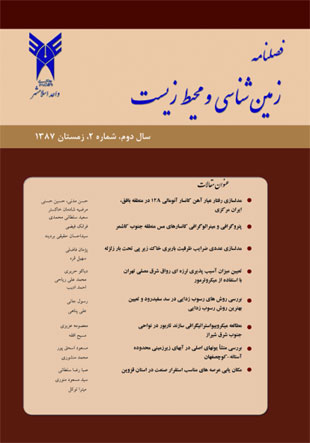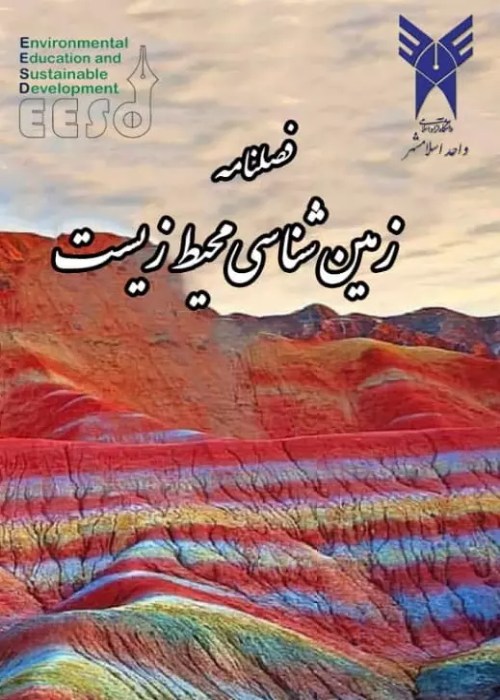فهرست مطالب

نشریه زمین شناسی محیط زیست
پیاپی 5 (زمستان 1387)
- تاریخ انتشار: 1387/10/11
- تعداد عناوین: 8
-
Page 1Anomaly No.12A iron deposit is located in Bafgh block in Central Iran. In exploration period, 19 exploratory boreholes were drilled. According to results, the grade behavior is composed of three populations. Since dividing these population physically and geologically was not possible, therefore, the whole grade population was considered as one. In this regard, the normal, lognormal and three parameter lognormal models have been studied. According to the results, the three parameter model was chosed for the deposit.Keywords: Grade Modeling, Iron, Anomaly No.12A, Central Iran
-
Page 9Dahaneh Siah, Cheshmeh Gaz, Zangalu and Cheshmeh Zelzeleh deposits are located in Kashmar 1:250000 geological map in north of Doruneh fault. This area belongs to Sabzevar zone. According to litho logic studies, the volcanic rocks vary in composition from Basaltic Andesite to Andesitic Basalt and Andesite as host rock and their adjacent rock units are Limestone and Tuffs. The mineralizationare occurred in contraction fractures around the Andesitic clasts and also disseminated in Andesite fractures. Dominant texture in Dahaneh Siah deposit is Porphiritic and Trachytic, Vesicular, Amygdaloidal are distinguished too. Plagioclases vary in composition between Oligoclase and Andesine. Biotite, green and Brown Hornblende have seen together and primary Pyroxenes containDiopside, Augite and Hypersthene. Inclusions of idiomorphic Appetites exist in Fe – Mg minerals or in matrix. Accessory minerals are Magnetite, Esphen and zircon. Vesicles are filled by Calcite, Chlorite and Quartz. Plagioclases altered to Clay minerals in Cheshmeh gaz deposit. The main mineral in Zangalu is Plagioclase and accessory minerals are altered Olivine and Pyroxene. Main minerals in Cheshmeh Zelzeleh are Pyroxene and Plagioclase and accessory mineral is the Olivinewhich is Altered to Ferro oxide and Serpentine. There is no opaque mineral in polished sections of this deposit. Paragenesis of minerals in Dahaneh Siah, Cheshmeh Gaz and Zangalu contain: Magnetite → Pyrite → Chalcopyrite → Chalcocite → Bornite → Hematite → Covellite → Copper → Malachite → Chrysocolla → Lepidocrocite → Limonite.Keywords: Petrography, mineralography, copper deposits, Bardaskan, Kashmar
-
Page 21Evaluation of soil bearing capacity coefficients of has been the focus of a significant amount of studies by various researchers. In all conducted studies and analyses, by considering different forms of earthquake load with pseudo-static performance, different results have been obtained. In this research, evaluation of soil bearing capacity coefficients under earthquake load has been carried out using finite elements software Plaxis and the obtained results have been compared with those from other published studies. Moreover, the effect of the inertia of the underpinning soil on the soil bearing capacity coefficients was modeled in the pseudo- static mode and the results indicated that bearing capacity coefficients obtained from pseudo-static gave good agreement with other methods. However, comparison of these two results revealed that the results obtained from numerical modeling are more conservative and are on the safety side. Finally, since the pseudo –static load is not characterized as an appropriate alternative for the earthquake load; the effect of underpinning soil on the manner of transferring the earthquake waves until reaching the foundation bed has been also investigated.Evaluation of soil bearing capacity coefficients of has been the focus of a significant amount of studies by various researchers. In all conducted studies and analyses, by considering different forms of earthquake load with pseudo-static performance, different results have been obtained. In this research, evaluation of soil bearing capacity coefficients under earthquake load has been carried out using finite elements software Plaxis and the obtained results have been compared with those from other published studies.Keywords: Numerical modeling, Foundation bearing capacity, Earthquake load, Finite elements, Pseudo static load
-
Page 31Because of the Microtremor analysis is easy and cheap, so that this method is used for definition of seismic vulnerability of structures. Consequently, we recorded microtremors in a few pointssimultaneously on the second floor and foundation floor in East Ravagh of Mosala of Tehran for evaluation of seismic vulnerability in this structure. After analysis of these data, we determined the points with high degree of seismic vulnerability.Keywords: Microtremor, Seismic Vulnerability
-
Page 43According to big dam's International commit report, nowadays more than 40000 big dam exist and used to provide water, produce energy, and controlling flood. deposition destroys about 0.5 to 1 percent of dams’ reservoir in every year, so building annually 200-400 great dams is needed. And ignoring, not only cause it to become worse but also it will make solution finding harder. In thisresearch the methods of discharging sediments like dredging, current density and flushing in sefidrud dam is studied. Dredging is not a suitable method because of project hard nesses and economic problems. Current density was the limiting factor to use better of this method, because of a cut off dam located in 150 meters far from the upstream river, so only flushing method is suitable for discharge sediment if environmental harms reduced.Keywords: Discharge sediment, density current, dredging, flushing
-
Page 55In this work, 2 astratigraphy sections of Tarbur Formation (including astratigraphy Darab section and astratigraphy Shesh-deh section) were investigated. Over 333 meters of sediments of this Formation and 328 thin sections are studied. The studies show that Tarbur Formation in Darab sections includes 2 distinct parts of limestone thin bedded and thick bedded. Also, 3 distinct parts of limestone thin bedded, medium bedded and thick bedded in Shesh-deh section, were observed. In these sections, thefollowing index foraminifers were recognized: Orbitoides media, Omphalocyclus macroporus, Dicyclina schulumbergri, Dicyclina sp., Dictyoconella sp., Dicytoconella compalanta, Minoxia sp., Nezzazatinella sp., Rotalia sp., Rotalia skouransis, Antaliya korayi, Antalya sp., Broekinella sp., Lepidorbitoedes sp., Siderolites sp., Loftusia minor, Salpingoporella turgida, Salpingoporella dinarica, Vania anatolica Hence, Orbitoides media & Omphalocyclus macroporus Assemblage Zone wereconsidered for Tarbur limestone formation. According to above mentions, we determined Maastrichtian- Paleocene age for Darab section and Maastrichtian age for Shesh-deh section.Keywords: Microbiostratigraphic, Tarbur Formation
-
Page 69Sefidrood river watershed is located in 9 provinces of Iran consist of 3 subwatershed of Ghezelozan, Shahrood and endparts of Sefidrood. In order to determination of origin of major ions in aquifer of Astaneh-Koochesfehan study area that is located in central parts of Gilan province and end parts of Sefidrood River, data from 25 deep and shallow quality wells with maximum depth of 15 m during 11 period from September 2003 to September 2008 and 4 hydrometry station on 3 mentioned subwatersheds was analyzed. Pole Astaneh and Beyne Rahe Roodbar are located in end parts of Sefidrood subwatershed and Shahrood and Gilavan are located on Shahrood and Ghezelozan river subaequentely.The study area is located between longitudes of 370000-430000 m and latitudes of 4099000-4150000 m in UTM system in zone of 39N. Astaneh Ashrafiyyeh is the largest city in the study area. Lithology of the study area consist of deltaic deposits and Sefidrood River alluvials spreading from Emamzadeh Hashem to Sefidrood Delta in Caspian sea coast as a fan with a head in the south and a long side in the north. Well samples are classified as natural waters and classified as C3S1 when Sefidrood samples in Gilevan Station as C4S2 and 3 other stations are classified as C3S1. Relatively high EC and TDS decreasing water taste quality. Relatively low quality of Sefidrood River water and better quality of Disam River water influences groundwaters. There is no evidence of sea water intrusion in the groundwaters. Water type is Calcium and magnesium bicarbonate. Using linearregression equation and determination coefficient between anions and cations results that bicarbonate is originated from dissolution of limestone formations in the study area or Great Sefidrood watershade, chloride is interred in the groundwaters resulting from dissolution of evaporation deposits in the Ghezelozan watershade and sulfate from dissolution of evaporation deposits in Ghezelozan watershade and leaching of potash fertilizers from soil.Keywords: Hydrogeochemistry_Groundwater_Astaneh – Koochesfehan_Sefidrood River
-
Page 79It is necessary to take action in regard to solving problems such as the unbalanced population throughout the country, the rate of migrating to big cities and the ecology destruction caused by wrong Industrial Site Selection with using the right industrial developmental policies. Correct Site Selection and right industrial designing are considered as a giant leap in environmental and industrial development in the country and the correct and logical growth of city and rural areas. That’s why in this research the industrial site selection in the province of Ghazvin has been done based on Boolean Algebra in the 1:250000 scale, using map overlaying. Environmental resources were classified analyzed and studied at first and measuring the ecological capacity of the land depending on the specified goal was designed according to the Three Classification Model and done after overlaying the layers in GIS. As a result after removing the preserved area of Bashgol and other areas in which industrial plantation was prohibited, 2 areas with the capacity of 1 and 11 areas with the capacity of 2 were selected. Other areas which were considered as having the capacity of 1 are forests or are being used in dry farming and industrial plantation in these areas is bound to the ministry of agriculture and other related organization’s consent.Keywords: GIS, Industrial Site Selection, Ecological Capability Evaluation, Boolean Algebra


